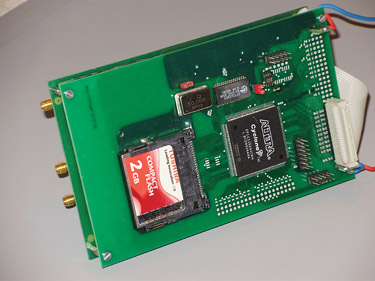FMI into the Low VHF Band

Recently, my colleague, Linley Gumm and I conducted tests of susceptibility of DTV downconverters to FMI when tuned to Channel 6.
I wanted to run these tests without using any off-air signals so the procedure could be used in any laboratory by others. I have an ATSC exciter, shown in Fig. 1, whose output can be heterodyned to any desired TV channel. Unmodulated signals from HP signal the generators to simulate six undesired FM radio signals.
We devised two triplets of FM band carrier frequencies. The first set produces no third-order distortion (IM3) products falling in Channel 6; the other produces a known number of IM3 within Channel 6. The first set was to act as a control as it would not generate any IM3 within the desired channel. The total power of the first set of FM carriers was made equal to the power of the other set. So would the first set of triplets, which does not generate any IM3 in the desired channel, affect DTV reception?
What we found was that with the set that generates IM3 in the desired channel set the minimum usable DTV signal power is only a few dBs lower than the set that did not generate IM3 in the desired Channel 6.
SUSCEPTIBILITY TO FMI
All DTV downconverters we tested behaved in the same way. A plot of the test data was published in my column in the Jan. 20 issue (“A New Kind of FMI on the Horizon?”). The tests of FMI into Channel 11 were published in the June 10, 2009 issue (“Testing for DTV Interference”). Both articles can also be found online at www.tvtechnology.com.

Fig. 1: Modern ATSC exciter with built-in Flash Memory provides 11 minutes of moving pictures and accompanying sound. IF output is at 44 MHz; RF output 434 MHz. Either can be heterodyned to any TV channel. Power required 12 volts, 0.5 amps. This experiment showed that these DTV downconverters were subject to FMI when receiving DTV signals on Channel 6 even if the FM band signal frequen-cies did not generate IMs products in the desired channel.
So, what was going on? Why did the minimum usable received signal power have to be increased dB for dB with the undesired FM signal power?
The behavior of the control triplet showed that even with a perfectly linear mixer, one that generates no IM3, FMI to DTV reception of Channel 6 may result in reception failure. All units we tested were susceptible to FMI, but why?
We knew that all units tested have wideband RF Automatic Gain Control (AGC) loops. In a wideband RF AGC system, the signal power is detected before the IF filter, so strong signals on adjacent channels cause the RF AGC detector to generate a DC voltage, which reduces the gain of the RF amplifier.
The FCC had noted that its tests of DTV downconverters showed that the interference from a signal on channel N+/–1 was less than for a signal on N+/–2. This suggests that the designers of DTV downconverters were able to meet the NTIA performance specifications for Adjacent Channel Interference (ACI) by employing wideband RF AGC loops which passed signals on N+/–1, but attenuated somewhat signals on N+/–2 and so on.
Our tests for FMI into Channel 11 showed that FMI was not affecting the gain of the RF amplifier. There was 100 MHz between the FM signals and the DTV signal on Channel 11.
Don’t blame wideband RF AGC for this problem. It is reducing both this problem and the ACI problem on all channels. That is why it was chosen by design engineers.
The NTIA issued some 63 million coupons to enable the public to buy subsidized DTV downconverters. Many of these have a single-conversion conventional tuner similar to those used in most DTV receivers. Therefore our test results sampled the performance of both downconverters and DTV receivers.
Broadcasters operating on Channel 6 should expect FMI and should be happy to know that there is something they can do about it. Fairly inexpensive FM traps can be connected between the coax cable and their DTV receiving device. Broadcasters on other Low VHF channels may also encounter FMI, but to date I haven’t run any tests other than for Channel 6 and that had surprising results. I do intend to test the robustness of DTV downconverters when receiving other low VHF Band channels, so stay tuned.
I have heard of instances where DTV reception was okay during the day, but at night it failed. In each of these instances, the problem was at a great distance from the transmitter. There are a number of possible explanations but the cause(s) cannot be determined for lack of details. I would be very interested in re-ceiving reports of instances of day/night fading. I will e-mail you a brief questionnaire if you contact me by e-mail: cwr@bootit.com.
MULTIPATH IN LOW POWER
If the FCC proceeds to repack the DTV spectrum again as has recently been proposed by the CEA and CTIA, it appears that our present terrestrial TV broad-casting system of a central, high-power transmitter, and a high-gain transmit antenna radiating from a great height will soon be over. It would be replaced by Distributed Transmission Systems (DTS), the FCC term for multiple disbursed lower-power transmitters throughout the station’s present coverage area.
I have serious concerns about the viability of such a broadcast service. While some homes in some shadowed neighborhoods would benefit, others would lose some or possibly all channels. This would be because of multipath interference, a problem not yet proven to have a solution for a single-carrier DTV signal (ATSC). I know of no laboratory tests of multiple ATSC signals synchronized and on the same channel, simulating a DTS system implementation.
The least costly way for broadcasters to transition to DTS would be to co-locate all DTV transmitters on the same set of short towers. Just how the public would react to this large number of towers (“Not in my backyard!”) cannot be foretold, but the experience broadcasters had with neighborhood property owners in Denver is well known. It took an act of Congress to override the property owners’ objections in the Denver case. If all of these small transmitters are on the same site and share the same antenna that will help with mutual interference, but for those receiving sites without a direct line-of-sight to the nearest tower, they might not receive any DTV signals reliably.
In any case, the technical questions with universally implementing DTS in a country with our asymmetrical single-carrier modulation scheme have not been answered. Sure, if we were to adopt the European DVB-T or the Japanese ISDB-T Standard, both of which employ COFDM (a symmetrical multicar-rier modulation) that implementation could be based on the experience already gained by broadcasters in Europe and Japan. But isn’t it a bit late to change DTV standards in North America?
As this column noted, approximately 63 million coupons were sent out by the NTIA, so I assume there are 60 million or so DTV downconverters in use today, and millions more nearly new ATSC receivers. Maybe Congress would reimburse the public for the cost to replace 60 million set-top boxes and perhaps 30 million DTV receivers. Then again, maybe the public will have to pay for this changeover if DTS does not turn out to work well with our ATSC signal as the only free TV-to-the-home delivery system in the United States.
Charles Rhodes is a consultant in the field of television broadcast technologies and planning. He can be reach via e-mail at cwr@bootit.com.
The professional video industry's #1 source for news, trends and product and tech information. Sign up below.
